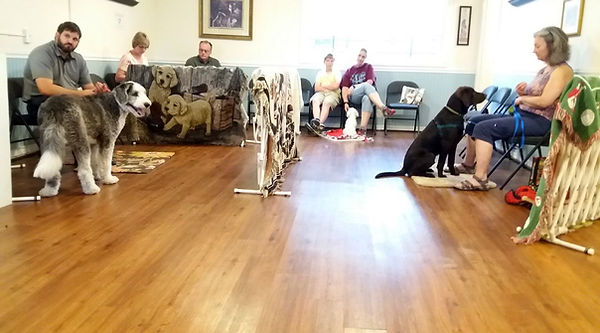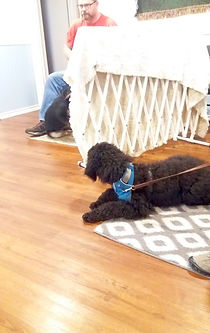
Making tails wag since 1996!
3400 N. Monroe St. - Spokane, WA
Questions? EMAIL!
When You Come to Class
Week one of the beginning classes is the class orientation and training for the human end of the leash. Pups stay home. This will give you the ability to focus on the lessons without the distraction of managing your dog. (We will need a couple of demo dogs!) Week two, all the dogs will join us.
Make sure your dog is extra hungry and well-exercised!
Choose a seat by neighbors that you think your dog will be most comfortable sitting near. If your dog is leery of men in hats or with beards, or of children, don't sit by one! If your dog is excitable, choose a calmer corner of the room. If your dog is shy, choose a low traffic seat - away from doorways and hallways. Ask your instructor if you need help finding an optimal seat. If you are hard of hearing, choose a seat directly across from the instructor's chair. Let us know if you need us to speak up!
You are your dog's advocate at all times. Don't be afraid to say, "not right now" if someone asks if they or their dog can meet your dog. Create a space buffer by placing yourself between your dog and anything that worries or excites him.


How is your dog feeling? What does your dog need to make this the best experience today? If he is worried, he may cope better under your chair where he feels protected until he gets acclimated. Please don't drag him out. He's not being a "chicken" - he's just saying, "I can't do this right now." Give him time. He will come out when he feels better. Protect his personal space so he feels safe.
If your dog puts on the brakes and can't walk through a door or passed another dog or person, please don't drag them. The more you pull, the more they panic. If they are small enough, you might pick them up so they feel safe. The front entrance is often easier as the door opens into a hallway rather than the classroom and the instructor can easily help you from there.
Party Animals! Read this article for help for dogs who "just love other dogs" whose enthusiasm may get them in trouble.
Safety Gates. Your instructor may set up portable gates to help worried dogs feel protected and distracted dogs have an easier time in the classroom. This will keep them from having to endure the gaze and proximity of other dogs or people, and to help social butterflies be less distracted so they can focus on their owners. If you need a gate, please ask!


Eyes and noses to themselves. Pay attention to how the dogs around you are feeling. Your dog may be super-friendly but if the dog he is dying to meet is shrinking away, or if your dog's gaze is causing another dog to act up, please redirect your dog and get his attention back on you. If you notice that a worried soul is sneaking a peek around the gate, keep your dog's attention on you so he can safely do so!
Barking in class. There are many reasons your dog might bark in class - and, chances are, yours won't be the only one, even if it seems like it! Obviously, in order for you and others to hear the instructor and to keep the stress level of the room in check, we must do our best to keep barking to a minimum. Keep your dog busy and reward his focus on you so he doesn't fixate on others.
Why do they bark? A room full of unfamiliar dogs and people can be pretty exciting and a little overwhelming. Dogs bark when they are worried, alarmed, excited, happy, or surprised. A lot of barking is out of frustration. Dogs may bark if something changes in the environment. They may bark at movement, and they may bark if something suddenly goes still. They bark if they notice that another person or animal is looking at them. They may bark out of the blue at something that was there all along, but suddently they notice it.
Dogs also bark when they have a physical need: when they are desperate to relieve themselves or need a drink. Usually it will be obvious what is setting them off, but sometimes you won't have any idea why he's carrying on or suddently explodes.



Here are some tips to help keep your dog on track:
-
Work on the settle on your mat exercise at home all week, so he's good at it before he comes to class.
-
Dogs bark at what they see, so work a lot on attention. When he's looking at something else, practice luring him in an arc to bring him back to face you more easily when he gets distracted in class. Practice marking and rewarding offered attention at home in the house, on the front steps, at the park, and at the coffee shop. "Yes!" and reward every time he happens to look at you, and he will look at you more often. Auto-check-ins are worth their weight in gold.
-
Give him a nice, long, relaxing walk to expend extra energy. Remember that 'wound up games' can contribute to a wound up dog instead of wearing him out. He should be relaxed and satisfied, not super-charged by the activity!
-
Watch him - where is he looking? What just caught his attention? Don't wait for the bark. If he zeroes in on something, redirect him quickly before he has a chance to bark. If he's calm, give him a second to look and then call him back.
-
Set up visual barriers. There are portable gates in various corners of the room for your use. There are blankets to cover the gates to create more of a visual barrier as needed. Gradually reduce the blanket or move the barriers so your dog can see more of the room as he is ready. This may happen during the first class or it may be many classes before he is ready. Your instructor will direct you as to when.
-
Keep your dog busy while the instructor is talking. If there are two of you, one can reward for calm & quiet while the other listens to the instructor. If you are alone, keep one eye on your dog while you listen and continue to reward him intermittently for small increments, growing into durations of quiet, relaxed attention. Bring a kong or pacifier chew (bully stick, stuffed Kong, water buffalo horn, etc. His class pacifier should be something novel that he doesn't get at home.)
-
Leash tension increases body tension and directly contributes to barking out of frustration. If your dog is sitting or lying quietly near you, be sure his leash is slack and not tight. If it helps, tie a knot in your leash at the perfect length so he doesn't have enough leash to wander off his mat, but there is no tension when he is close. This will give you a place to grip in case he lunges suddenly, while maintaining zero tension on the leash. When it's time to work on exercises, it's often easiest to have another family member hold the leash while you work with the dog.

Learning to work and focus around other people and puppies, it's not easy at first!
Learning to settle at your feet begins at home.
Practice makes perfect!
Teaching your wiggly pup that he needs to lie down and be still when there are other things he'd rather be doing takes lots of practice. Start at home where it is quiet. The more time you spend on this exercise at home, the easier it will be for your puppy to lie quietly in class with all the other pups and people. We are creating the habit that when his person settles, he should settle, too. But more than that, we are laying the foundation to help him learn to be able to lie quietly in public when there are many distractions.
When you deliver the treat, make sure you place it deliberately between his paws, one right after another at first - maybe 5 or 6 treats in a row as fast as he can pick them up and eat them without getting up. Then add a slight pause in between rewards. If he pops up, take note. You waited too long or the distractions were too great. Keep it short and the rate of reinforcement high at first.
As he relaxes and kicks over onto one hip as he waits for the next installment, you can begin to extend the pause. You are building patience and a confident down-stay and relax.
Say "yes" when you see a tiny moment of stillness.
Then deliver a treat between his paws. A tiny glimmer of patience gets marked with a "yes" so he knows THAT is why he is getting the next treat. Be sure to release him "all done!" and encourage him to get up when you have accomplished the length of time you were after. All the treats stop when you release him. (If you did a good job of reinforcing him for being still, he may not want to get up at all!)

Notice the nice slack leash - no tension!
(c) Diamonds in the Ruff, all rights reserved